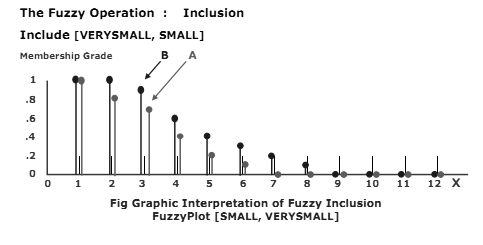Fuzzy Operations
A fuzzy set operations are the operations on fuzzy sets. The fuzzy set operations are generalization of crisp set operations. The fuzzy set theory in the terms of standard operations: Complement, Union, Intersection, and Difference.
The graphical interpretation of the following standard fuzzy set terms and the Fuzzy Logic operations are illustrated:
Inclusion : FuzzyInclude [VERYSMALL, SMALL]
Equality : FuzzyEQUALITY [SMALL, STILLSMALL]
Complement : FuzzyNOTSMALL = FuzzyCompliment [Small]
Union : FuzzyUNION = [SMALL ∪ MEDIUM]
Intersection : FUZZYINTERSECTON = [SMALL ∩ MEDIUM]
Inclusion :-Let A and B be fuzzy sets defined in the same universal space X. The fuzzy set A is included in the fuzzy set B if and only if for every x in the set X we have A(x) ≤ B(x)
Example : The fuzzy set UNIVERSALSPACE numbers, defined in the universal space X = { xi } = {1, 2, 3, 4, 5, 6, 7, 8, 9, 10, 11, 12} is presented as SetOption [FuzzySet, UniversalSpace → {1, 12, 1}]
The fuzzy set B SMALL
The Set SMALL in set X is : SMALL = FuzzySet {{1, 1 }, {2, 1 }, {3, 0.9}, {4, 0.6}, {5, 0.4}, {6, 0.3}, {7, 0.2}, {8, 0.1}, {9, 0 }, {10, 0 }, {11, 0}, {12, 0}}
Therefore SetSmall is represented as SetSmall = FuzzySet [{{1,1},{2,1}, {3,0.9}, {4,0.6}, {5,0.4},{6,0.3}, {7,0.2}, {8, 0.1}, {9, 0}, {10, 0}, {11, 0}, {12, 0}} , UniversalSpace → {1, 12, 1}]
The fuzzy set A VERYSMALL
The Set VERYSMALL in set X is : VERYSMALL = FuzzySet {{1, 1 }, {2, 0.8 }, {3, 0.7}, {4, 0.4}, {5, 0.2}, {6, 0.1}, {7, 0 }, {8, 0 }, {9, 0 }, {10, 0 }, {11, 0}, {12, 0}}
Therefore SetVerySmall is represented as SetVerySmall = FuzzySet [{{1,1},{2,0.8}, {3,0.7}, {4,0.4}, {5,0.2},{6,0.1}, {7,0}, {8, 0}, {9, 0}, {10, 0}, {11, 0}, {12, 0}} , UniversalSpace → {1, 12, 1}]

Comparability :-Two fuzzy sets A and B are comparable
if the condition A ⊂ B or B ⊂ A holds, i.e.,
if one of the fuzzy sets is a subset of the other set, they are comparable.
Two fuzzy sets A and B are incomparable
If the condition A ⊄ B or B ⊄ A holds.
Example 1:
Let A = {{a, 1}, {b, 1}, {c, 0}} and B = {{a, 1}, {b, 1}, {c, 1}}.
Then A is comparable to B, since A is a subset of B.
Example 2 :
Let C = {{a, 1}, {b, 1}, {c, 0.5}} and D = {{a, 1}, {b, 0.9}, {c, 0.6}}.
Then C and D are not comparable since C is not a subset of D and D is not a subset of C.